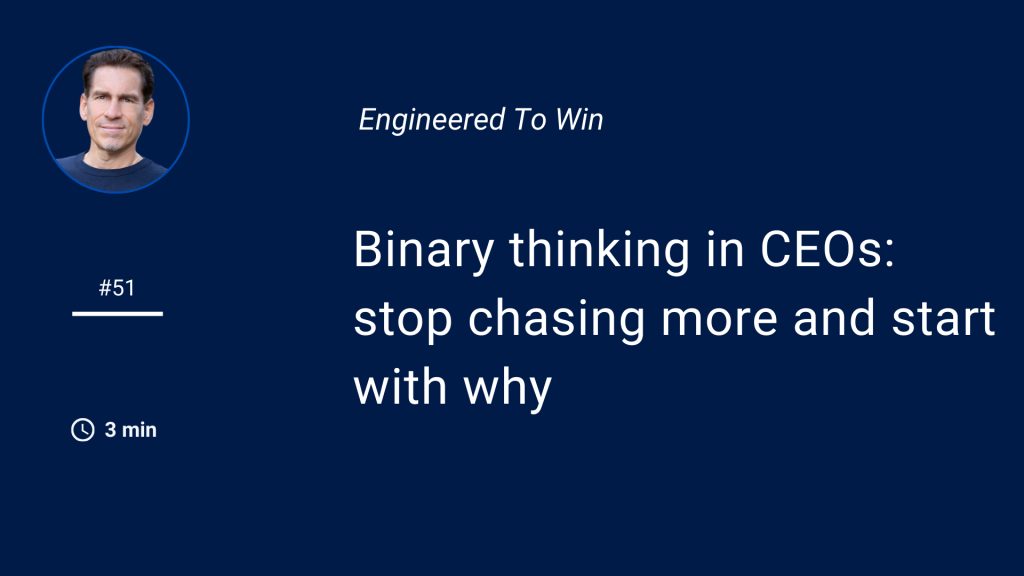Binary thinking in CEOs is the silent tax on clarity. When decisions collapse into this or that, many male founders default to doing more—faster—without knowing why. The result? More motion, less meaning, and a company that scales confusion instead of conviction.
The “This or That” Trap fueling binary thinking in CEOs
Male CEOs—socialized to equate decisiveness with strength—are praised for quick calls. Under pressure, the brain loves shortcuts. It collapses complex landscapes into this or that:
- Hire or fire
- Launch or kill
- Cut or double down
- Raise or bootstrap
Useful sometimes. Disastrous when it replaces thinking.
Binary thinking shows up as speed chasing clarity. But speed without orientation compounds error. Simon Sinek’s core insight—Start With Why—is the antidote. When your why is fuzzy, “more” becomes a nervous-system habit, not a strategy. You’re winning the sprint and losing the marathon.
What your nervous system is doing (beneath the suit)
Under stress, the brain narrows options to conserve energy. That’s adaptive for survival, not for strategy. Narrowing becomes compulsive: we pick a single path just to relieve tension.
Stephen Kessler’s Five Personality Patterns (Leaving, Merging, Enduring, Aggressive, Rigid) explain why different leaders default to different “more” loops:
- Rigid: seeks the one right answer → perfection or paralysis
- Aggressive: pushes harder → “more force solves it”
- Enduring: carries more load → “I’ll take it on”
- Leaving: escapes into ideas → ideate more, decide less
- Merging: seeks support → more meetings, less ownership
None of these are “bad.” They’re protective survival styles. Unexamined, each pattern feeds the “do more, feel less” loop.
Backed by science, grounded in results
When pressure rises, binary thinking in CEOs spikes because working memory collapses and the brain seeks the fastest relief, not the best decision.
Your working memory can juggle only a few variables at once. Under load, the brain compresses complexity into oversimplified choices—classic fuel for binary thinking in CEOs. Purpose (your why) recruits broader neural networks, improving persistence and discrimination. In plain English: clarity of why expands your map and calms the limbic urge to fix everything with more.
Sinek made this practical: when why is clear, what and how become obvious. Without why, you’re just upgrading the treadmill.
Escaping binary thinking in CEOs isn’t about more effort—it’s about better orientation to why.
How to break binary thinking in CEOs
1) Ask the third option
When you catch “A or B,” insert C:
- What option C makes A and B irrelevant?
- What delayed option D becomes viable in 90 days?
- What micro test turns this into learn vs. guess?
2) Run the Why–What–How Cascade (Sinek in 90 seconds)
- Why: What meaningful change are we creating? For whom?
- What: Which single constraint must move first?
- How: What 15-minute experiment will prove/kill it this week?
3) Pattern-aware decisions (Kessler in the boardroom)
These flips reduce binary thinking in CEOs during high-stakes calls:
- Rigid → “Good enough, shipped.”
- Aggressive → “Less force, more feedback.”
- Enduring → “Delegate the next step now.”
- Leaving → “Time-boxed decision today.”
- Merging → “One owner, one deadline.”
4) Use the six mental faculties to widen the map
- Imagination: list 5 non-obvious plays
- Intuition: what feels true beneath the noise?
- Perception: what if the opposite were true?
- Memory: when did a slower decision save us?
- Reason: what data would falsify our favorite idea?
- Will: what will we not do this quarter?
The 60-Minute Why Audit: From “More” to Meaning
Use this to replace binary thinking in CEOs with evidence-based learning.
- Inventory (10 min): list every initiative you’re pushing now.
- Why Rank (15 min): for each, write a 1-sentence why. Score 1–5 for clarity. ≤3 is a risk.
- Binary Break (15 min): for the bottom 50%, craft a third option (combine, pause, delegate, replace with a test).
- Constraint Focus (10 min): pick one initiative with a 4–5 why score. Define the single constraint to move this week.
- Commitment (10 min): assign one owner and a 15-minute experiment. Put it on the calendar.
Bonus: Say no to one “good idea” that doesn’t strengthen your why. Your nervous system will thank you. 🙂
Expert lens: why before how
“People don’t buy what you do; they buy why you do it.” — Simon Sinek, Start With Why
“Patterns are survival styles—not your true self.” — Step
Escape velocity: Binary thinking in CEOs → Founder with range
When you build from why, the brain widens options. You stop demanding certainty from action and start demanding direction from purpose. You move from either/or to both/and to neither—do the right thing next.
Remember one of my core beliefs: Progress is a process and patience is the pathway. The fastest way to go faster is to remove the noise.
Reflection question: Where are you pushing for more because you don’t yet have a clear why?
Recommended Tool
MetaMap OS™ — Metacognitive Mapping
Map your decision in 10 minutes: why → constraint → experiment. It externalizes your thinking so you can edit it like a blueprint. This short-circuits binary thinking in CEOs and restores strategic range.
Call to action
Reply with your one-sentence why for the initiative consuming the most energy this week. I’ll send back one question to sharpen it.

